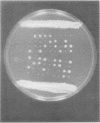Abstract
Yeast Saccharomyces cerevisiae may express an a or alpha mating type. These cells types may be interconverted as a consequence of heritable genetic alteractions at the mating type locus (MAT). According to the more general controlling element model [Oshima, U. & Takano, I. (1971) Genetics 67, 327--335] and the specific cassette model [Hicks, J., Strathern, J. & Herskowitz, I. (1977) in DNA Insertion Elements, Plasmids and Episomes, eds. Bukhari, A. I., Shapiro, J.A. & Adhya, S. L.(Cold Spring Harbor Laboratory, Cold Spring Harbor, NY), pp. 457--462], the regulatory information required for switching the MAT locus exists at two other loosely linked loci, HMa and HMalpha. Specifically, the HMa and HMalpha loci are proposed to carry silent alpha and silent a genes, respectively. According to these models, switching occurs when a replica of a silent gene replaces the resident information at the mating type locus and is thereby expressed. These models predict that mutations at the silent ("storage") loci would generate defective MAT loci subsequent to the switching process. Therefore, the behavior of HMalpha mutants during the mating type interconversion was investigated. The results demonstrate that defective MATa alleles are generated by switching the MATalpha locus in HMalpha mutants. Thus, the genetic information from HMalpha is transposed to the mating type locus. These results provide genetic evidence in support of these models.
Full text
PDF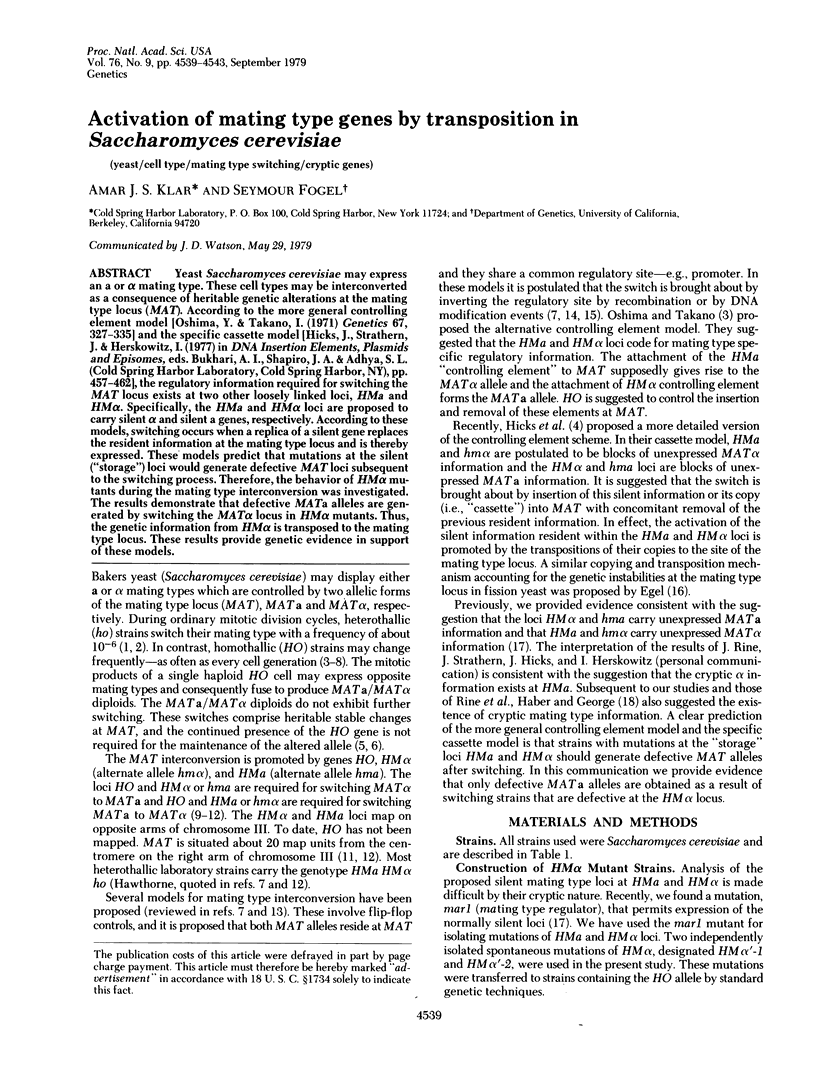
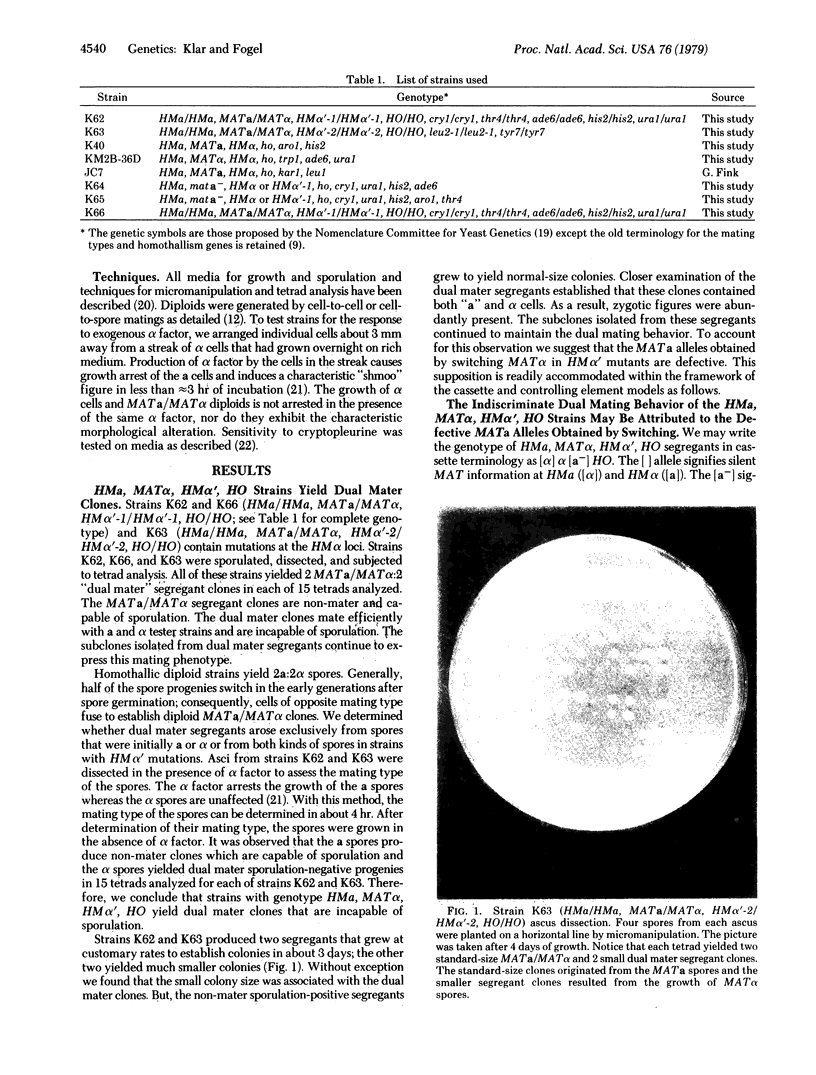
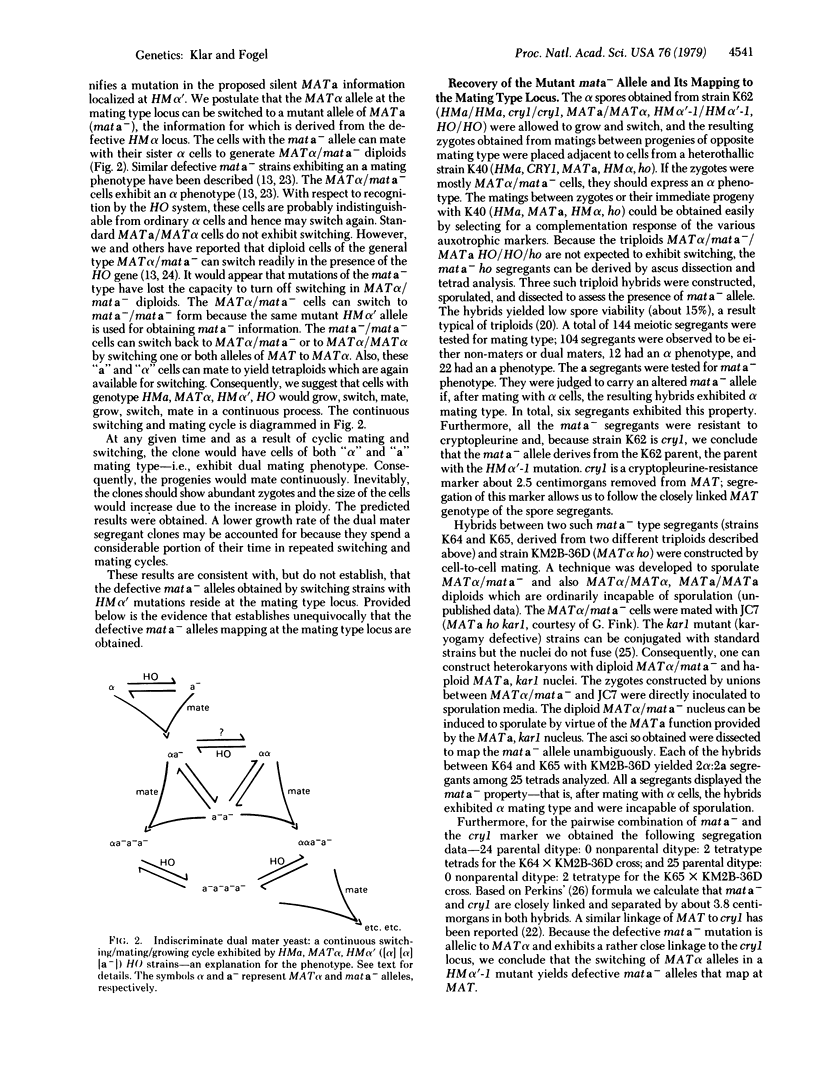
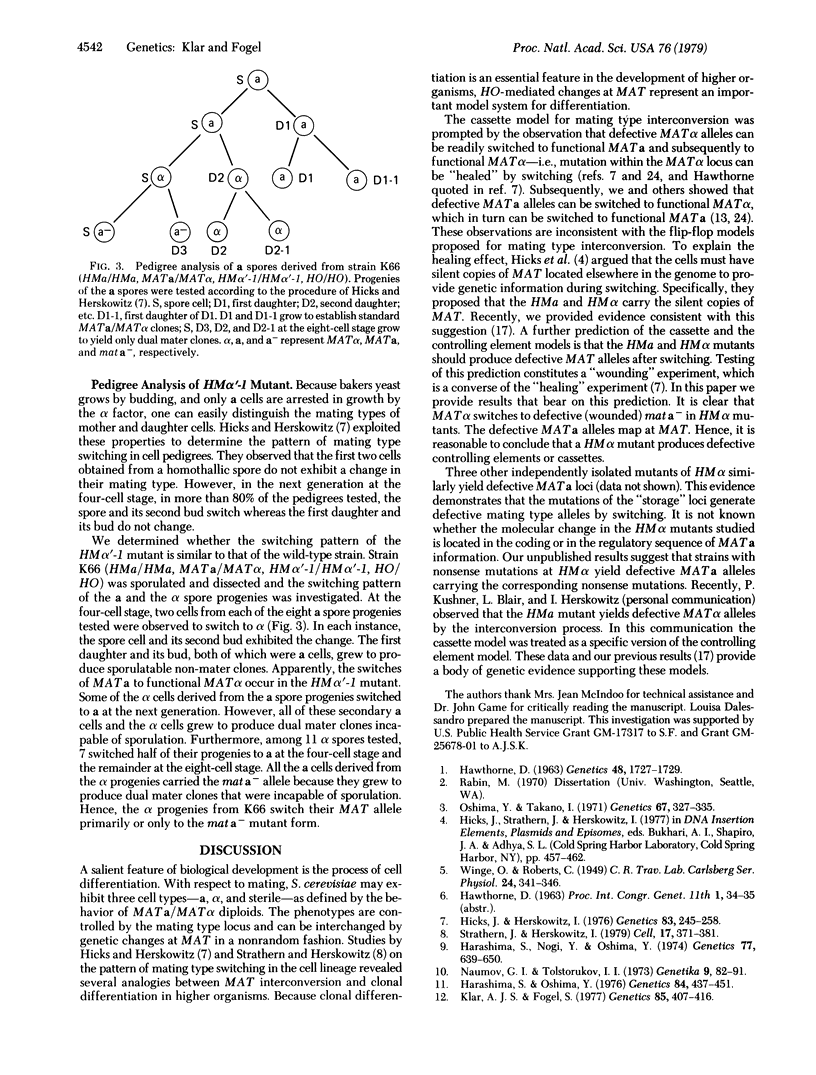
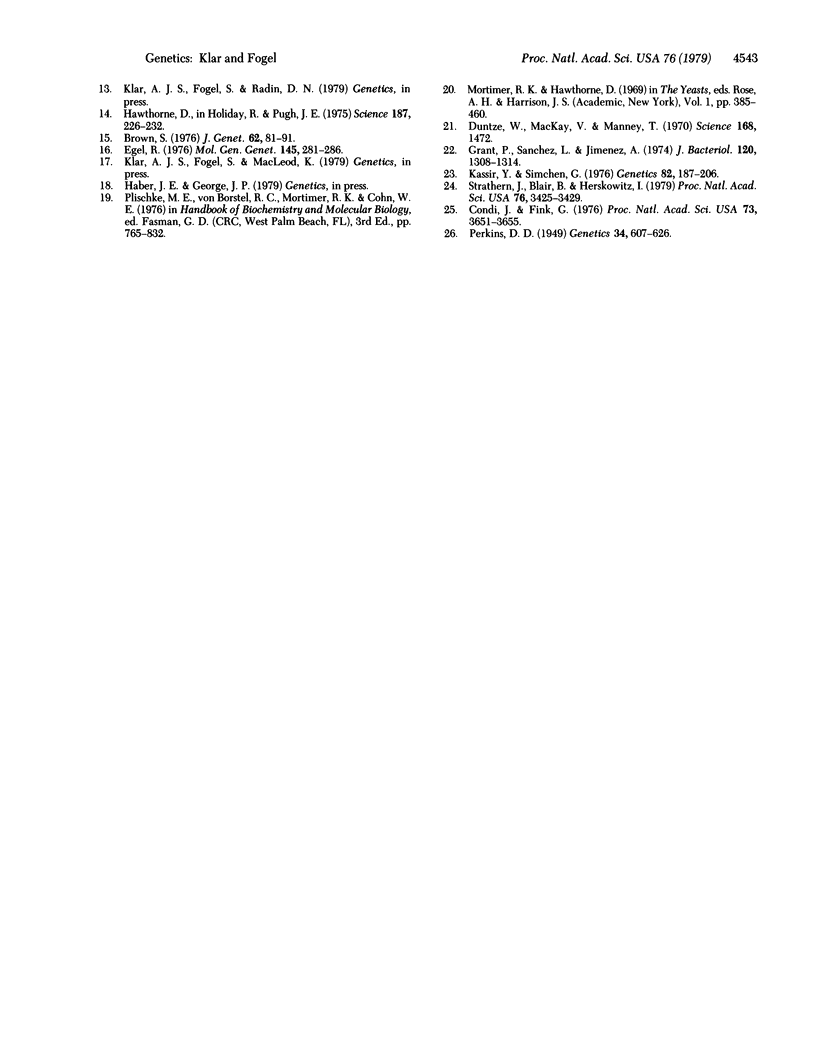
Images in this article
Selected References
These references are in PubMed. This may not be the complete list of references from this article.
- Conde J., Fink G. R. A mutant of Saccharomyces cerevisiae defective for nuclear fusion. Proc Natl Acad Sci U S A. 1976 Oct;73(10):3651–3655. doi: 10.1073/pnas.73.10.3651. [DOI] [PMC free article] [PubMed] [Google Scholar]
- Duntze W., MacKay V., Manney T. R. Saccharomyces cerevisiae: a diffusible sex factor. Science. 1970 Jun 19;168(3938):1472–1473. doi: 10.1126/science.168.3938.1472. [DOI] [PubMed] [Google Scholar]
- Egel R. The genetic instabilities of the mating type locus in fission yeast. Mol Gen Genet. 1976 Jun 15;145(3):281–286. doi: 10.1007/BF00325824. [DOI] [PubMed] [Google Scholar]
- Grant P., Sánchez L., Jiménez A. Cryptopleurine resistance: genetic locus for a 40S ribosomal component in Saccharomyces cerevisiae. J Bacteriol. 1974 Dec;120(3):1308–1314. doi: 10.1128/jb.120.3.1308-1314.1974. [DOI] [PMC free article] [PubMed] [Google Scholar]
- HAWTHORNE D. C. A DELETION IN YEAST AND ITS BEARING ON THE STRUCTURE OF THE MATING TYPE LOCUS. Genetics. 1963 Dec;48:1727–1729. doi: 10.1093/genetics/48.12.1727. [DOI] [PMC free article] [PubMed] [Google Scholar]
- Harashima S., Nogi Y., Oshima Y. The genetic system controlling homothallism in Saccharomyces yeasts. Genetics. 1974 Aug;77(4):639–650. doi: 10.1093/genetics/77.4.639. [DOI] [PMC free article] [PubMed] [Google Scholar]
- Harashima S., Oshima Y. Mapping of the homothallic genes, HM alpha and HMa, in Saccharomyces yeasts. Genetics. 1976 Nov;84(3):437–451. doi: 10.1093/genetics/84.3.437. [DOI] [PMC free article] [PubMed] [Google Scholar]
- Hicks J. B., Herskowitz I. Interconversion of Yeast Mating Types I. Direct Observations of the Action of the Homothallism (HO) Gene. Genetics. 1976 Jun;83(2):245–258. doi: 10.1093/genetics/83.2.245. [DOI] [PMC free article] [PubMed] [Google Scholar]
- Holliday R., Pugh J. E. DNA modification mechanisms and gene activity during development. Science. 1975 Jan 24;187(4173):226–232. [PubMed] [Google Scholar]
- Kassir Y., Simchen G. Regulation of mating and meiosis in yeast by the mating-type region. Genetics. 1976 Feb;82(2):187–206. doi: 10.1093/genetics/82.2.187. [DOI] [PMC free article] [PubMed] [Google Scholar]
- Klar A. J., Fogel S. The Action of Homothallism Genes in Saccharomyces Diploids during Vegetative Growth and the Equivalence of hma and HMalpha Loci Functions. Genetics. 1977 Mar;85(3):407–416. doi: 10.1093/genetics/85.3.407. [DOI] [PMC free article] [PubMed] [Google Scholar]
- Manuilova E. S., Shapiro N. I. Izuchenie geneticheskogo kontrolia chuvstvitel'nosti kletok mlekopitaiushchikh k letal'nomu i mutagennomu deistviiu ul'trafioletovykh luchei. Genetika. 1973 Nov;9(11):82–89. [PubMed] [Google Scholar]
- Oshima Y., Takano I. Mating types in Saccharomyces: their convertibility and homothallism. Genetics. 1971 Mar;67(3):327–335. doi: 10.1093/genetics/67.3.327. [DOI] [PMC free article] [PubMed] [Google Scholar]
- Perkins D. D. Biochemical Mutants in the Smut Fungus Ustilago Maydis. Genetics. 1949 Sep;34(5):607–626. doi: 10.1093/genetics/34.5.607. [DOI] [PMC free article] [PubMed] [Google Scholar]
- Strathern J. N., Blair L. C., Herskowitz I. Healing of mat mutations and control of mating type interconversion by the mating type locus in Saccharomyces cerevisiae. Proc Natl Acad Sci U S A. 1979 Jul;76(7):3425–3429. doi: 10.1073/pnas.76.7.3425. [DOI] [PMC free article] [PubMed] [Google Scholar]
- Strathern J. N., Herskowitz I. Asymmetry and directionality in production of new cell types during clonal growth: the switching pattern of homothallic yeast. Cell. 1979 Jun;17(2):371–381. doi: 10.1016/0092-8674(79)90163-6. [DOI] [PubMed] [Google Scholar]



